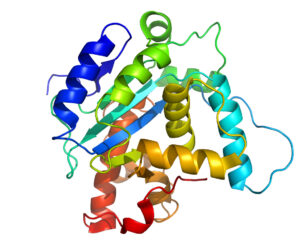Table of Contents
What are Enzymes?
Proteins that act as biological catalysts or biocatalysts are known as enzymes. Catalysts help to speed up chemical reactions. Substrates are molecules that enzymes can interact with, and the enzyme converts the substrates into different molecules known as products. Enzyme catalysis is required for almost all metabolic processes in the cell to occur at rates fast enough to sustain life.
Enzymology is the study of enzymes, and enzymes are known to catalyze over 5,000 different biochemical reactions. Another type of biocatalyst is ribozymes, which are catalytic RNA molecules. The three-dimensional structure of enzymes determines their specificity.
A brief note:
Structure:
Enzymes are globular proteins that can function independently or as part of a larger complex. The amino acid sequence determines the structure, which in turn determines the enzyme’s catalytic activity. Despite the fact that structure determines function, a novel enzymatic activity cannot yet be predicted solely on the basis of structure. When enzyme structures are heated or exposed to chemical denaturants, they unfold (denature), and the structure is disrupted, resulting in a loss of activity. Enzyme denaturation is normally associated with temperatures above a species’ normal range; as a result, enzymes from bacteria living in volcanic environments, such as hot springs, are prized by industrial users for their ability to function at high temperatures, allowing enzyme-catalyzed reactions to run at a high rate.
Enzymes are typically much larger than the substrates they work with. The monomer of 4-oxalocrotonate tautomerase contains only 62 amino acid residues, compared to over 2,500 in animal fatty acid synthase. The catalytic site (roughly 2–4 amino acids) is a small portion of their structure that is directly involved in catalysis. This catalytic site is near one or more binding sites where substrates are oriented by residues. The catalytic and binding sites make up an enzyme’s active site. The active site’s precise orientation and dynamics are maintained by the remainder of the enzyme structure.
Enzymes, like any other catalyst, are not consumed in chemical reactions and do not change the reaction’s equilibrium. Enzymes are distinct from other catalysts in that they are much more specific. Other molecules can affect enzyme activity, such as inhibitors and activators. Inhibitors reduce enzyme activity, while activators increase it. Enzyme inhibitors are found in many therapeutic drugs and poisons. When an enzyme is exposed to excessive heat, its activity decreases dramatically, and many enzymes are (permanently) denatured, losing their structure and catalytic properties. Commercially, some enzymes are used in the production of antibiotics, for example. Enzymes are used in a variety of household products to speed up chemical reactions.
What exactly do enzymes do?
- The digestive system – Enzymes help the body break down larger, more complex molecules like glucose into smaller molecules it can use as fuel.
- Every cell in your body contains DNA, which is replicated. A cell’s DNA must be copied every time it divides. Enzymes help with this by unwinding DNA coils and copying the information.
- Liver enzymes – the liver is in charge of the body’s toxin breakdown. It accomplishes this by utilizing a variety of enzymes.
Enzyme properties can be divided into three categories:
Physical properties:
- Enzymes behave like colloids or high-molecular-weight substances in terms of their physical properties.
- At temperatures far below the boiling point of water, enzymes are destroyed or become inactive.
- Most enzymes in liquid medium are inactivated at 60 degrees Celsius.
- Dried enzyme extracts can withstand temperatures ranging from 100 to 120 degrees Celsius, and even higher. Enzymes are thus thermos-labile.
- Every enzyme has a specific temperature range for optimum activity, which usually falls between 25 and 45 degrees Celsius. When the temperature reaches 37 degrees Celsius, enzymes become inactive, and when the temperature reaches 60 degrees Celsius, enzymes become inactive.
Chemical properties:
- Enzymes are biological catalysts with catalytic properties. The larger quantities of substances are catalyzed by a small number of enzymes. It means that enzymes have a high capacity for converting large amounts of the substrate to the product. Enzymes accelerate reactions while remaining unaffected by the reactions they catalyze.
- Enzyme specificity: Enzymes are highly specific in nature, meaning that only one enzyme can catalyze a single reaction. Enzyme sucrase, for example, can only catalyze sucrose hydrolysis.
General properties:
- Enzymes are proteins that start and speed up biochemical reactions.
- The acidity of the medium affects enzyme activity (pH specific). At a certain pH, each catalyst is most active. For example, pepsin has a pH of 2 and trypsin has a pH of 8.5. The pH of most intracellular enzymes is close to neutral.
- Enzymes have the ability to speed up a reaction in either direction.
- Active sites are found in all enzymes and are involved in biochemical reactions.
- Enzymes are highly unstable compounds that can only be dissolved in water, dilute glycerol, NaCl, and dilute alcohol.
- At the right temperature, enzymes are active.
- Enzymes are proteins in nature, but not all proteins are enzymes.
- Enzymes reduce the energy required to activate a substance molecule, allowing the biochemical reaction to occur at body temperature, which is 37 degrees Celsius.
Importance of chapter for neet and board exams:
Many young medical aspirants fail to balance their preparation for NEET and Class 12 board exams. The pressure to do well in Class 12 boards is enormous in a country like ours, where many people compete for a single mark. As a result, candidates preparing for both the NEET and the Class 12 board examinations must be able to juggle the two effectively.
This article on ‘how to prepare for NEET and Class 12 board exams at the same time aims to assist candidates in preparing for both exams at the same time. The NEET 2022 exam is scheduled to take place in the first week of May, while the CBSE Class 12 board exam will begin in February/March.
Also read: Enzyme Action
FAQs:
1. What are 5 facts about enzymes?
Ans:
- Catalysts improve the efficiency and effect of the body’s metabolism, which is essentially just an enormous series of continuous chemical reactions.
- The fact about enzymes is that they aid the liver’s activity and glucose production. Enzymes in the blood transport carbohydrates to various parts of the body, supplying the muscles with the energy they need to function properly.
- It aids in the management of obesity. They are not a weight-loss product, but they do aid in the efficient and easy absorption of food, reducing the amount of it converted to fat. It is much easier to reduce the amount of fat that our bodies accumulate rather than to do so later.
- As we get older, our body’s ability to produce enzymes decreases. Our bodies appear to produce less lipase, protease, and amylase, enzymes that break down fats, proteins, carbohydrates, and other foods.
- Because an enzyme derived from plants is commonly prescribed for use as a substitute to break down a wide variety of foods, including starch, milk, fats, and carbohydrates, plant-derived enzymes are effective across a broad body pH spectrum.
- Because an enzyme derived from plants is commonly prescribed for use as a substitute to break down a wide variety of foods, including starch, milk, fats, and carbohydrates, plant-derived enzymes are effective across a broad pH spectrum.
- Protectins, fats, and carbohydrates are the basic foods that the body breaks down and absorbs. Your body makes the protease, lipase, and amylase enzymes from these.
2. What enzymes function?
Ans: In 1894, the “lock and key” model was proposed for the first time. The active site of an enzyme is a specific shape in this model, and only the substrate will fit into it, like a lock and key. The induced-fit model has been updated to replace this model. The active site changes shape as it interacts with the substrate in this model. The catalysis can begin once the substrate is fully locked in and in the exact position.
3. What is the mechanism of enzyme action?
Ans: An enzyme attracts substrates to its active site, catalyzes the chemical reaction that produces products, and then dissociates the products (separate from the enzyme surface). The enzyme-substrate complex is the combination of an enzyme and its substrates. The complex is called a ternary complex when two substrates and one enzyme are involved; a binary complex is when one substrate and one enzyme are involved. Electrostatic and hydrophobic forces attract the substrates to the active site, which are referred to as noncovalent bonds because they are physical rather than chemical bonds.
4. What is an enzyme made of?
Ans: Proteins made up of amino acids linked together in one or more polypeptide chains are known as enzymes. The primary structure refers to the amino acid sequence in a polypeptide chain.









